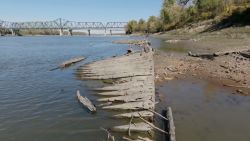Editor’s Note: Bob Litterman is a founding partner at Kepos Capital, the former head of risk management at Goldman Sachs and chaired the CFTC subcommittee that produced the Managing Climate Risk in the U.S. Financial System report. The opinions expressed in this commentary are his own.

Last week, the window in my San Francisco home office, which is normally so bright that the shade is pulled down, was dark all day. The sun never shone over the city, where I am sheltering in place. The air is, and has been, dangerously unhealthy for weeks now. This nightmare has now spread over the entire western coast of the United States.
This is a preview of what a rapidly warming planet has in store. Unless we reduce carbon emissions, the wildfires will only get worse. In today’s polarized world, it’s easy to become cynical and think reducing carbon emissions will never happen. But last week, I found hope in – of all places – a Commodity Futures Trading Commission subcommittee charged with studying the threat that climate change poses to our financial and economic system.
As the smoke filled the San Francisco sky, this committee, which I chaired and which includes representatives from banks, insurance, oil, agriculture, data companies, investors, asset owners, academics and environmentalists, unanimously adopted the position that climate risk will upend our economy if left unaddressed. They recommended a series of steps we must take to account for the risk and reduce emissions quickly.
Here are our recommendations:
Congress must establish a price on carbon immediately
Incentives matter, and the financial system cannot direct capital appropriately on its own to combat the effects of climate change.
The cost of pollution through greenhouse gas emissions and the resulting global warming are not born by the emitter, but rather by the entire human population and the environment. The appropriate solution is to price carbon by charging emitters for the quantity of carbon dioxide, or CO2, they release into the atmosphere.
Financial market participants are incredibly efficient at directing capital where it will be most productive. The problem right now is it that they face the wrong incentives. Potential for catastrophic outcomes, like wildfires, floods, heatwaves, droughts and more and larger hurricanes, are not being priced appropriately, so in some cases, capital flows toward increasing emissions. A great example of this is found in current expensive oil exploration, which is done through deepwater drilling, Arctic development and mining tar sands in Canada and Venezuela. If we had a tax on carbon, capital used to develop these oil sources would likely have been deemed too expensive, and the capital would have flowed elsewhere.
This is an urgent risk management failure that needs to be corrected through meaningful legislation.
Plan for extreme risk
The risks associated with climate change are many and complex. We must prepare for extreme scenarios where climates risks to the economy could interact with one another, amplifying shocks and disrupting multiple parts of the financial system simultaneously.
The climate risks to the economy are often divided into physical risk and transition risk. Physical risk arises from the impairment of economic activity and the corresponding impact on asset performance from the shocks and stresses attributable to climate change – like droughts cutting into crop yields or, as we are seeing now, fires destroying people’s homes. Transition risk is associated with the financial impact that could result from a rapid and disorderly transition to a net-zero emissions economy – like the coal miners who have found themselves jobless and without adequate retraining, or oil investors who may find themselves holding reserves they can no longer profitably develop.
Risk management requires consideration of extremely bad, but plausible scenarios. Given how long-lasting and uncertain the future impacts of climate change will be, being prepared implies that we must proceed with extreme caution.
We must act quickly
When it comes to the climate, the reality is that we do not know exactly how much time we have. This makes the problem extraordinarily urgent. The longer we go without a price on carbon the higher we can expect the Earth’s peak temperature, raising the risk of catastrophic impacts, and leaving pollution in the atmosphere that future generations will have to deal with.
Public and private sectors must work together
Financial regulators must work with the private sector to address climate risk in financial markets. The subcommittee came up with over 50 specific recommendations, ranging from how stress testing and scenario analysis should be used to calculate exposures to which types of climate-related risk information should be disclosed.
We have a choice. We can continue on our current path of ignoring the economic cost of climate risk and find ourselves facing potentially catastrophic economic and ecological losses. Or, we can make the global transition to a net-zero emissions economy through adaptation, construction of sustainable infrastructure and the rapid reduction of carbon dioxide in the atmosphere the important investing goals of the next several decades.





















